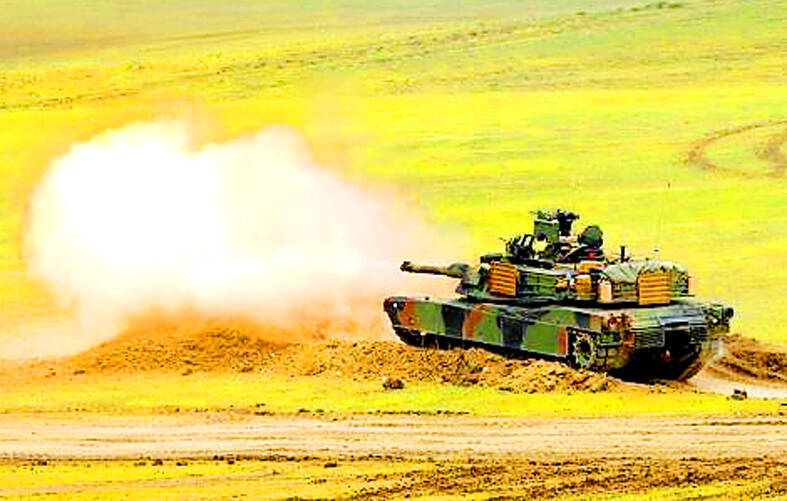The nation’s defense capability is to see a boost over the next four years, as the military is expected to acquire major equipment such as M1A2T tanks, light cruisers and F-16V jets, but production delays are likely to continue posing challenges.
With some analysts saying that Beijing is eyeing an invasion deadline of 2027, Taiwan’s military readiness over the coming years is of critical importance.
Based on the Ministry of National Defense’s published budgets, the military from now until 2027 is scheduled to receive a significant amount of new armaments.

Photo: Reuters
The army is to receive delivery of 108 M1A2T Abrams main battle tanks and 29 M142 High Mobility Artillery Rocket Systems (HIMARS), while the navy is expecting nine more Tuo Chiang-class corvettes, a new type of rescue ship, the domestically developed Hai Kun (海鯤) submarine, two light cruisers and 32 shore-mounted Harpoon missile systems.
In the air force, delivery of 39 more Yung Ying (勇鷹) advanced jet trainers, 66 F-16V Block 70 jets and four MQ-9B drones are expected.
In addition, a special budget implemented from 2022 is providing the funds necessary to acquire missiles and advanced ships by 2026.
This in particular includes the Wan Chien (萬劍) cluster munitions missile optimized for striking enemy airports that is to enter mass production this year, while the Hsiung Sheng (雄昇) surface-to-surface cruise missile and Chien Hsiang (劍翔) drone for countermeasures on land are to be acquired by next year.
However, the acquisition of new equipment has not always been smooth.
Impacts over the past few years from the COVID-19 pandemic and the Russian-Ukraine war have delayed military production capacity across the globe, including that of US equipment already purchased by Taiwan.
For example, the first two of the 66 F-16Vs purchased by Taiwan were scheduled for delivery last year, and all were to be delivered by 2026.
However, the ministry in May last year updated its delivery forecast for the first batch to the third quarter of this year, although it kept the 2026 estimate for completion of the entire order.
As for the four purchased MQ-9B drones, the ministry last year told lawmakers that it hoped for delivery in two batches next year, but revised the estimate to 2027 due to flight testing, training and other factors.
Despite concerns about delays as large shipments of Javelin and TOW anti-tank missiles are being diverted to Ukraine, the ministry’s budget for this year is unchanged from last year.
The army is expecting receipt of 1,240 TOW missiles and 200 Javelin missiles this year, showing that the delivery schedule has not been affected.

People can preregister to receive their NT$10,000 (US$325) cash distributed from the central government on Nov. 5 after President William Lai (賴清德) yesterday signed the Special Budget for Strengthening Economic, Social and National Security Resilience, the Executive Yuan told a news conference last night. The special budget, passed by the Legislative Yuan on Friday last week with a cash handout budget of NT$236 billion, was officially submitted to the Executive Yuan and the Presidential Office yesterday afternoon. People can register through the official Web site at https://10000.gov.tw to have the funds deposited into their bank accounts, withdraw the funds at automated teller

PEACE AND STABILITY: Maintaining the cross-strait ‘status quo’ has long been the government’s position, the Ministry of Foreign Affairs said Taiwan is committed to maintaining the cross-strait “status quo” and seeks no escalation of tensions, the Ministry of Foreign Affairs (MOFA) said yesterday, rebutting a Time magazine opinion piece that described President William Lai (賴清德) as a “reckless leader.” The article, titled “The US Must Beware of Taiwan’s Reckless Leader,” was written by Lyle Goldstein, director of the Asia Program at the Washington-based Defense Priorities think tank. Goldstein wrote that Taiwan is “the world’s most dangerous flashpoint” amid ongoing conflicts in the Middle East and Russia’s invasion of Ukraine. He said that the situation in the Taiwan Strait has become less stable

CONCESSION: A Shin Kong official said that the firm was ‘willing to contribute’ to the nation, as the move would enable Nvidia Crop to build its headquarters in Taiwan Shin Kong Life Insurance Co (新光人壽) yesterday said it would relinquish land-use rights, or known as surface rights, for two plots in Taipei’s Beitou District (北投), paving the way for Nvidia Corp to expand its office footprint in Taiwan. The insurer said it made the decision “in the interest of the nation’s greater good” and would not seek compensation from taxpayers for potential future losses, calling the move a gesture to resolve a months-long impasse among the insurer, the Taipei City Government and the US chip giant. “The decision was made on the condition that the Taipei City Government reimburses the related

FRESH LOOK: A committee would gather expert and public input on the themes and visual motifs that would appear on the notes, the central bank governor said The central bank has launched a comprehensive redesign of New Taiwan dollar banknotes to enhance anti-counterfeiting measures, improve accessibility and align the bills with global sustainability standards, Governor Yang Chin-long (楊金龍) told a meeting of the legislature’s Finance Committee yesterday. The overhaul would affect all five denominations — NT$100, NT$200, NT$500, NT$1,000 and NT$2,000 notes — but not coins, Yang said. It would be the first major update to the banknotes in 24 years, as the current series, introduced in 2001, has remained in circulation amid rapid advances in printing technology and security standards. “Updating the notes is essential to safeguard the integrity